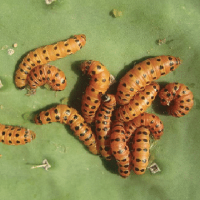Host plants
The cactus moth is restricted in its choice of hosts to only a few genera in the subfamily Opuntioideae (prickly pears) of the cactus family (Cactaceae) and always prefers species in the genus Opuntia. Large Opuntia hosts, e.g., O. ficus-indica and O. robusta are more tolerant to attack than smaller hosts because of the hard woody stems of large plants that are not suitable for larval feeding.
Damage
The larvae are gregarious feeders. They cause severe damage by hollowing out the inside of several cladodes, also known as leaf pads. Damage is compounded by microbial pathogens that enter the affected plant parts. Infested cladodes are easily recognized by the faeces and slimy green ooze that are discharged through the entrance hole. Having consumed a cladode, the larvae either tunnel to an adjacent one or the entire colony will leave the cladode and crawl over the plant surface before entering another suitable cladode. Affected plants show the typical rotting cladodes (illustrated) that eventually dry out to form papery white empty shells. Small plants are more vulnerable to damage than larger plants.
The cactus moth is not a serious pest on cultivated mature cactus pear when normal orchard sanitation practices are followed. Young orchards, if not protected, can be severely damaged.
Life history
There are two well defined generations per year. In the central and southern parts of southern African, moths appear first during February and March when eggs are laid and again during September and October. In the northern warmer parts the generations commence about a month earlier. Moths emerge in the early evening and mate the following day. Oviposition starts during the following evening. Females oviposit between two and four egg sticks, each egg stick containing about 60-90 eggs.
When host plants are abundantly available moth dispersal is limited to at the most a few kilometers. Some individuals are, however, capable of flying long distances of up to 100 km, often aided by air currents.
Eggs take about 50 days to hatch during the spring generation and 33 days during the summer generation. The egg stick changes colour from light brown to almost black prior to hatching. The first instar larvae enter the cladode collectively near the egg stick and they continue feeding internally for the entire duration of six larval stages. When mature, larvae leave the cladodes to pupate in the soil, in debris or in crevices or old cladodes on the plant. The pupal stage lasts about 73 days for the spring generation and 60 days for the summer generation.
Natural enemies
Life table studies have identified two generalist parasitoids which have a significant effect on moth populations. However, the most important factors influencing mortality are general predators, mainly ants, and the weather. Baboons and monkeys also excavate infected cladodes to remove the larvae and the pupae to eat.
The cactus moth remains a key natural enemy for many invasive Opuntia species in South Africa, e.g., O. ficus-indica, O. aurantiaca, O. stricta and others. It is important not to compromise this efficiency with introduced parasitoids that may switch to the cactus moth and so diminish its benefits. The benefits derived from the cactus moth far outweigh the damage it is causing to commercial cactus pear plantations.
Management
Orchard sanitation is by far the best and most cost-effective method of controlling the cactus moth. Hand collecting the conspicuous eggs sticks from the cladodes during the two window periods (February/March and September/October) when egg sticks are present is highly effective. The larvae from any egg sticks that are overlooked will hatch and enter a cladode. Such infected cladodes are easily detected and can then be removed and destroyed.
Chemical control of the cactus moth entails cover sprays aimed at destroying the eggs and first instar larvae during the two window periods (egg stages). Treating the endophagous larvae is difficult because of their inaccessibility within a cladode. To date, no systemic insecticide has been effective in killing these larvae. Chemical control against the cochineal insect , Dactylopius opuntiae is also effective against the cactus moth provided that treatment is confined to the two window periods when egg sticks are present.







